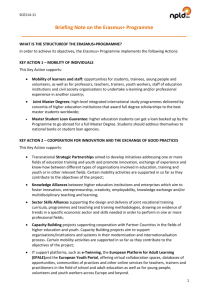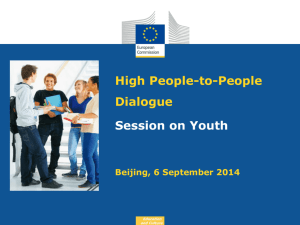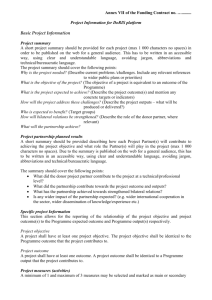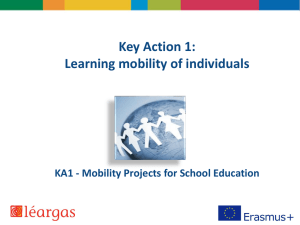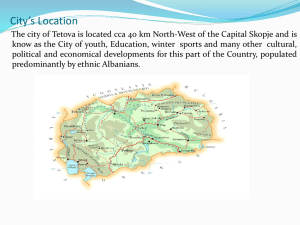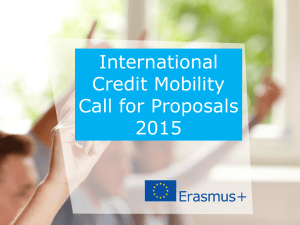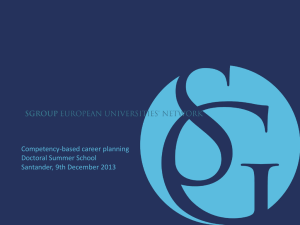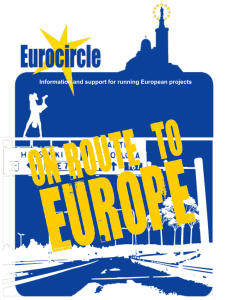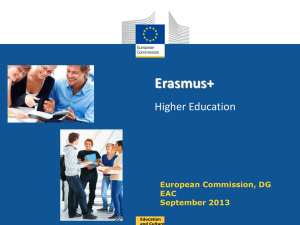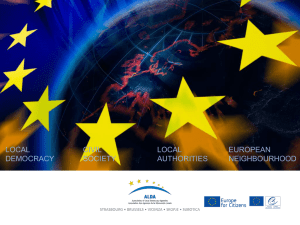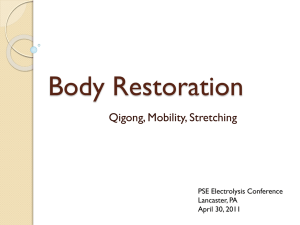Good Proposal
advertisement
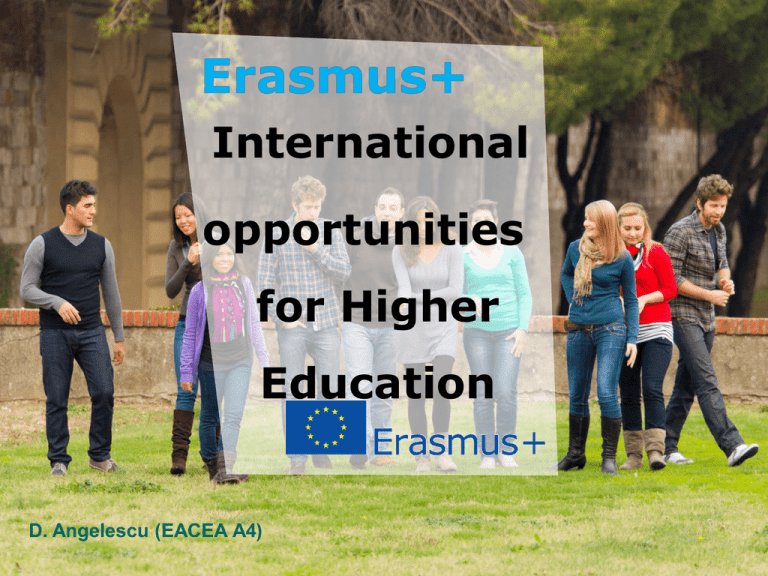
International opportunities for Higher Education Name D. Angelescu (EACEA A4) Education and Culture Education and Culture Content Successful vs. good proposals How should I start? Drafting a good proposal When can I start? Successful project Respect the Call requirements & criteria Be clear, well-structured, concise, to the point (see guiding questions in the Application Form) Manageable partnership Cost-effective Successful project Common requirements for all Erasmus+ International dimension – Centralised Actions Submission on-line to EACEA eForm (parts A & B) Criteria Eligibility Criteria Exclusion Criteria Selection Criteria Award Criteria Successful project Eligibility criteria Most of eligibility criteria (see E+ Programme Guide – CBHE action) are featured in the e-form; following criteria are double checked by the Agency staff: Formal submission requirements Grant size (and duration) Applicant, Partners and Partnership requirements (number of partners, status of the grant applicant & partners, etc.) Successful project Award criteria: (1) Relevance of the project Objectives and priorities of the Programme action (including general, specific and operational objectives) Well-defined target groups of the action Modernisation and internationalisation of participation organisations Genuine and adequate needs analysis Innovative and/or complementary character to other initiatives and projects already carried out EU added value Successful project Award criteria: (2) Quality of Project Design & Implementation Quality of the activities proposed Feasibility and innovative nature of the methodology proposed Cost-effectiveness & allocation of appropriate resources to each activity Quality of the overall project design in terms of consistency between project objectives, methodology, activities and budget proposed Completeness of the work programme, including appropriate phases for preparation, implementation, evaluation, follow-up and dissemination Quality control measures to ensure that the project implementation is of high quality, completed in time and on budget Quality of measures for identifying and selecting participants in the mobility activities to ensure a high quality mobility experience and recognition of learning outcomes of the participants Successful project Award criteria: (3) Quality of Project Team & Cooperation Appropriate mix of complementary participating organisations with the necessary profile, skills, experience, expertise and management support to successfully deliver all aspects of the project Distribution of responsibilities and tasks Effective mechanisms for coordination and communication between the participating organisations, as well as with individual participants and other relevant stakeholders Involvement of organisations / stakeholders from different sectors of education, training and youth, where relevant. Involvement of newcomers to the programme/action Successful project Award criteria: (4) Impact and Sustainability Impact foreseen on the organisations and individuals during and after the project lifetime Potential to produce multiplier effects outside the organisations and individuals Quality of the dissemination plan and identification of appropriate resources in each of the participating organisations to ensure a high quality dissemination to relevant stakeholders Quality of the plans for ensuring the sustainability of the project activities and outputs after the project lifetime attracting co-funding or other forms of support as well as mainstreaming and effective use/implementation of the project results From a project idea to a successful proposal A successful proposal demonstrates that the combination of all its elements will produce concrete and sustainable results for the benefit of all the parties concerned. Good project Necessary condition but… not sufficient ! A good proposal is a proposal that Has been prepared and agreed jointly by the partnership. Has received the full commitment and support of the participating institutions. Is ready to start immediately after the selection decision. All proposals start from individual initiatives. Good proposals are always the result of a joint institutional commitment. How can I start? 1. You have a "broad knowledge" of Erasmus+ What/who is it for? How does it work? What activities does it support and how? Who could help you understand it better? 2. You have a concrete idea for an international cooperation project Does it fit the programme' s objectives, priorities, requirements, intervention modalities, etc.? Does it address your institution (/sector /country) needs? 3. Your idea is supported by your institution You have discussed it with the relevant authorities You will be supported for the proposal preparation and, if successful, the project implementation 4. You can set up (/be part of) an international partnership for carrying out the project How can I build a strong partnership? Start locally In your institution (other colleagues, services, departments, authorities, etc.) Among local stakeholders (other universities, education providers, employers, local / regional / national authorities, NEOs in Partner Countries etc.) International partners Colleagues / Organisations you (/your partners) have worked with in the past Partners are not individuals, they are organisations Each partner must Bring a concrete added value to the project Gain a concrete added value from the project Cooperation is based on trust, confidence AND on formalized agreements Drafting the proposal Broad knowledge of Erasmus+ is not sufficient anymore You must become a "master" in the relevant Erasmus+ Action (objectives, priorities, requirements, criteria, etc.) Most probably, you will need to adapt your idea to the Action requirements. Drafting the proposal is a shared exercise It reflects the partners shared responsibilities at project implementation stage It requires regular revisions/rewriting in order to ensure Consistency and coherence Comprehensiveness Fulfilment of all the E+ Action requirements • Choose the language common/comfortable to all project partners Have your final Draft proofread by a colleague not involved in the proposal A good proposal is: COHERENT in its entirety; avoid contradictions; avoid "patchwork" SIMPLE: better a few well-chosen words than long/vague explanations CONCRETE: use examples, justify your statements, bring proofs CLEAR: Follow the questions and answer them in the right order EXPLICIT: do not take anything for granted; don't assume: experts cannot read your mind; avoid abbreviations or explain them RIGOROUS: the application is the basis on which your project will be implemented; it is also the cornerstone of your partnership commitment FOCUSED: stick to what is asked COMPLETE: ensure (twice!) you have followed all the instructions and that the proposal fulfils all the mandatory requirements. When can I start? Now ! Propose / Discuss potential cooperation projects within your institution (e.g., CBHE, JMD) If a mobility action is in view, What type of student mobility (level of study, duration, thematic area, type of activities, etc.) or staff mobility? What added value can you offer to incoming students / staff? Does your university fulfil the principles of the Erasmus Charter ? On what criteria will you select your EU mobility partners? Successful project Specific issues for E+ Capacity Building for Higher Education Award criteria Relevance of the project – 30 pts The national/regional priorities are addressed Focus on Partner Country needs Quality of the project design and implementation – 30 pts Academic / training content and the pedagogical approach Consistency between project objectives methodology, activities and budget proposed Coherence with the LFM Clearly identified challenges/risks of the project and mitigating actions proposed Quality of the project team and the cooperation arrangements – 20 pts Regional dimension and diversity Impact and dissemination – 20 pts Accreditation of new courses, study programmes etc. Successful project Specific issues for E+ Special Mobility Strand within Capacity Building for Higher Education Fully contributes to the achievements of the project objectives and is well articulated with them in particular in terms of subject areas / topics addressed by the project Added value to the project Quality measures to organise mobilities (sending and hosting institutions) including use of tools for mobility (bilateral agreements; learning agreements etc.) Mobility impact at beneficiary level Clear strategy for validation and recognition of participants' learning outcomes (students) and contribution of mobility to host institutions (staff) Mobility Strands components that score 5 points or less will not be considered for funding. Conclusion: Cooperation Projects 1. A good proposal is (much) more than a successful proposal. 2. Nobody else knows your institution/country needs better than you. 3. Have everybody on board as early as possible. Good luck !! Important link for the E form • https://eacea.ec.europa.eu/erasmusplus/funding/key-action-2-capacity-building-infield-higher-education-2015_en
